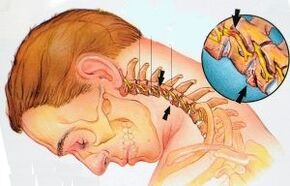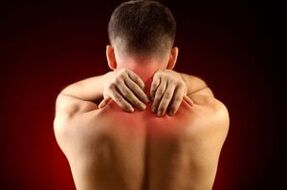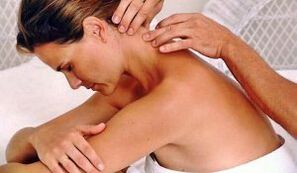
To the question: How to treat the osteochondrosis of the cervical column, there is an answer: to influence the cause of this disease yourself, if it is not an acute period.
Medicine deals with research: symptoms of the disease, not the cause.Therefore, do not wait for doctors, do not throw money in vain in ointments, teas, injections, physiotherapy, simulators, massages.None of the listed funds will help it.
Therefore, it is categorically to say that my personal experience in the treatment of cervical osteochondrosis, that I will be happy to share, with the hope that it helps one of you to face this problem.
However, success in treatment will depend on several conditions:
- Your desire to help yourself;
- Preparation to understand the true cause of cervical osteochondrosis;
- Fulfillment of the most strict self -discipline in the treatment.
What you need to know about the osteochondrosis of the cervical column
To answer the question:how to treat the osteochondrosis of the cervical column,It is necessary to understand the cause of the disease well.To understand it, you will have to resort to the anatomy of the spine.
Our column is a strong but flexible case for vital blood vessels and nerve trunks.Supporting the column in good condition means not having health problems.
But we, for ignorance or that we owe to a frivolous attitude towards health from an early age, we carefully treat the spine: load it too much, take uncomfortable postures, sit for hours on the computer or on the table during the sitting work, we spend a lot of time driving a car in a tense state, we have an incorrect position of overweight, etc.

The cervical column is the most mobile.It consists of seven vertebrae, among which there are elastic intervertebral discs.They are clearly visible in the figure.The discs make the column flexible and at the same time give strength.
Each intervertebral album consists of a fibrous ring, within which there is an octopoose core.
In the cervical column, the brain nerve and the vertebral artery pass, which, through branched nerves and blood vessels, feed not only the head next to the brain, but also the organs of the shoulder waist.
Cervical osteochondrosis are changes in the intervertebral discs of the cervical column as a result of physical, inflammatory or mental exposure.The elasticity and resistance of the intervertebral discs decrease, while their height also decreases.
In the future, if the disease is not treated, the fibrous ring of the intervertebral disc is squeezed and deforms, which can cause protrusion.In more severe cases, the fibrous ring of the disc is broken, and the pulpic nucleus protrudes in the form of hernia, while tightening the nerve endings that emerge from the vertebral holes, as shown in the figure.
So, the cause of cervical osteochondrosis is a change in intervertebral discs in the cervical column against the weak muscles.In addition, even slight muscle tension can lead to a displacement of vertebrae, as a result of which nerve endings are compressed and pain occurs.
But there are many factors, as a result of which there is a change in discs.This is a sedentary lifestyle and a hereditary predisposition, metabolic disorders and injuries, and the deposition of salts in the cervical column and others.
How does cervical osteochondrosis manifest?All symptoms indicate that, as a result of changes in intervertebral discs, innervation and blood supply to the brain, head, neck and shoulder strap are affected.Therefore, the symptoms of cervical osteochondrosis are headache on the back of the head and temples, Dizziness with a strong turn of the head, noise in the ears, a decrease in visual acuity, the deterioration of the ear, the pain in the neck, the shoulders, the shoulder blades, the hands and, sometimes, in the heart.
Dizziness with a strong turn of the head, noise in the ears, a decrease in visual acuity, the deterioration of the ear, the pain in the neck, the shoulders, the shoulder blades, the hands and, sometimes, in the heart.
If cervical osteochondrosis is not treated, then due to deteriorated brain circulation, diseases such as migraine, hypertension, vegetable dystonia, auditory problems, eyes, coordination, with cardiovascular and respiratory systems are developed.In advanced cases, ischemia and cerebral stroke can be developed.
Personal experience in the treatment of cervical osteochondrosis
The diagnosis is cervical osteochondrosis, they gave me a neuropathologist at the age of 45.Having observed the x-ray image of my neck, he wrote on the card next to the diagnosis: the height of the discs between the C5-C6 and C6-C7 vertebrae was significantly reduced.I was tormented by frequent headaches, playing in my ears, neck pain.
The question arose:How to treat the osteochondrosis of the cervical column.The doctor, "I calmly assured me that the osteochondrosis is impossible to heal completely, since the intervertebral discs were deformed. He prescribed me not cheap, at those prices, ointment and advised me to sit directly to the table. They were the 90s, I bought the ointment according to the recipe of a neuropathologist in some left pharmacy. But the ointment of the relief did not bring my life.
On the recommendation of acquaintances, I resorted to the services of a specialist paid in manual therapy with greater medical education.After he, having felt the cervical vertebrae, turned my head, seemed to be 180 degrees, became easy, illuminated and not painful.However, the procedure was clearly dangerous.The Manoalist warned that for three days you must sit at the table directly, and not in a favorite pose.

I followed the recommendations for two days, and then I forgot it.A few days later, my condition again became the same as before visiting a doctor, a manualist.This experience told me how to treat the osteochondrosis of the cervical column.Having reigned all literature on osteochondrosis, I realized that I had to independently affect the cause of the disease.The doctors here are not assistants.It is impossible to change the deformation of the discs, but it can stretch the cervical column and, therefore, reduce the pressure on nerve endings and blood vessels.
In the house we always had a horizontal bar, in the morning, hanging from it, you get a good stretching of the entire spine, except the neck.I tried many ways to stretch my neck and developed my own system for the treatment of cervical osteochondrosis:
- He changed his position.It was not easy and did not happen immediately, but the auto -discipline and motivation helped me feel healthy.I often looked at me in the mirror of my posture, I checked it, I approached the wall: my head should touch the wall, that is, to be in the same line with the heels.I always try to hold the head and straight shoulders.Today, when I am 60 years old, I have a better position than twenty years ago.
- Daily in the morning and at night I do the "turtle" exercise of the Tao revitalization system.Sometimes I do it more often if I feel tensions or hardening in the neck, the upper back or shoulders.Do the turtle turtle with sitting as in the figure:
- Lower the chin on the chest, pull your head up with your back.Inhale slowly.At this time, the back of the neck extends up and the shoulders fall;
- Exhale slowly, remove your head down, as if you wanted to touch them on the back of the neck.The chin stretches, the throat stretches slightly.The shoulders rise on both sides of the head, as if about to touch the ears;
- Repeat this cycle 10-12 times, trying to do everything slowly.
The exercise of the turtle contributes to the safe stretching of the cervical column, strengthens the muscles of the neck and shoulders, eliminates fatigue, hardening and pain, improves metabolism and rejuvenates the body.
- In addition to the "turtle", I exercise to relax all the shoulder waist, also sitting:
- Lift and lower your shoulders 10 times;Tilt your head slowly to the left, to the right 10 times to each shoulder;
- Tilt your head slowly forward, go back 10 times;
- I lean your head first to the right (the right ear to the right shoulder), then slowly, stretching the neck and pulling the head, rolling towards the column and the left shoulder.Then from the left shoulder, to the right.Make 10 cracks on each shoulder;
- Relax, straighten the spine again, balances the weight of the body in the cushion and begins to make circular movements slowly with a torso from left to right, then 10 times from right to left.At the same time, the head, the shoulders, the hands are relaxed in rotation.
This exercise, in addition to relaxation, arouses the healing forces of the body, normalizing the energy nutrition of all cells and organs.
- When I work on the computer for a long time, I put a necklace of the neck (you can buy in a pharmacy).I am not sitting in him for a long time, one or two hours.This allows you to keep your head straight.
- If I noticed that from an uncomfortable pose, for example, sitting next to the TV or working in the country, I had a sonar in the ears or headache, I relax immediately (as I read here), after which I do the exercise of the turtle.Calls and pain pass within 5-10 minutes.

The relaxation and stretching of the neck muscles and the shoulder girdle should become part of their daily life, then it will feel great, having a diagnosis such as cervical osteochondrosis.
Before starting the exercises, consult your doctor.
Here I want to keep in mind that such treatment is possible outside exacerbation.If you have an acute period of cervical osteochondrosis with nerve violation of hypothermia or any infection, consult a doctor and take the prescribed block, injections, etc.As soon as exacerbation can apply my method.
It is also a note: you can relax your neck muscles taking a hot shower on your neck or trapped in the bathroom.
Conduate a mobile lifestyle, but avoid acute shots of the head, a heavy load, since the shoulder muscles are tense, whose spasm will change the vertebrae and violate the roots of the nerves and blood vessels in the neck.
Sleep in a small pillow, often in fresh air, change negative thoughts to positive so that their tensions do not slip the cervical and shoulder areas, and do not exacerbate the symptoms of osteocondrosis.

Adhere to adequate nutrition.Exclude sugar and white bread, bakery products from your diet.Eat more vegetables, fruits and grain.
Now, I hope you understand how to treat the osteochondrosis of the cervical column.
Trust yourself and live without pain with your cervical osteochondrosis!






















